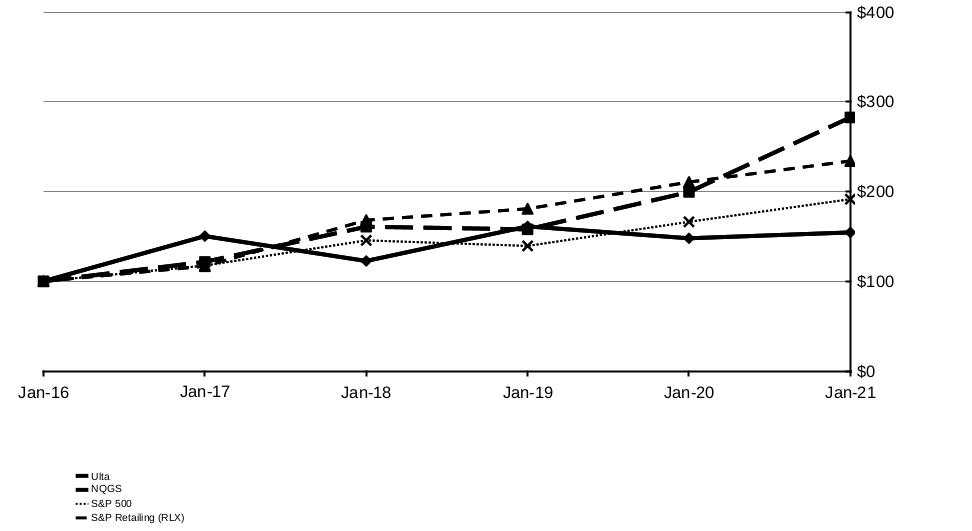personnel and store associates. Competition for this type of personnel is intense, and we may not be successful in attracting, assimilating, and retaining the personnel required to grow and operate our business profitably.
Our secured revolving credit facility contains certain restrictive covenants that could limit our operational flexibility, including our ability to open stores.
We have a $1.0 billion secured revolving credit facility with a term expiring in March 2025. Substantially all of our assets are pledged as collateral for outstanding borrowings under the agreement. Outstanding borrowings bear interest at either a base rate plus a margin of 0% to 0.125% or the London Interbank Offered Rate plus a margin of 1.125% to 1.25% and the unused line fee is 0.20% per annum. The credit facility agreement contains usual and customary restrictive covenants relating to our management and the operation of our business. These covenants, among other things, limit our ability to grant liens on our assets, incur additional indebtedness, pay cash dividends and redeem our stock, enter into transactions with affiliates, and merge or consolidate with another entity. These covenants could restrict our operational flexibility and any failure to comply with these covenants or our payment obligations would limit our ability to borrow under the credit facility and, in certain circumstances, may allow the lenders thereunder to require repayment.
Economic, Market and Other External Risks
The COVID-19 pandemic has had, and will continue to have, a negative impact on our business, financial condition, profitability, cash flows and supply chain, as well as consumer spending.
On March 11, 2020, the World Health Organization declared COVID-19 a global pandemic. Federal, state and local governments have since implemented numerous measures to try to contain the virus, such as travel restrictions, border closings, restrictions on public gatherings, quarantining of people who may have been exposed to the virus, shelter-in-place restrictions, and limitations or shutdowns of business operations. In response to government recommendations and for the health and safety of our associates (i.e., employees) and guests, on March 19, 2020 we temporarily closed all stores across the U.S. As a result of this decision, we experienced a significant reduction in customer traffic and demand which resulted in our sales and results of operations being negatively impacted. While we have reopened all stores, the potential temporary reclosing of certain stores in the future is possible. COVID-19 could also negatively impact our future results of operations by continuing to weaken demand for our products and services and/or by disrupting our supply chain.
The COVID-19 pandemic has significantly increased economic and demand uncertainty and has caused an economic slowdown that may continue. The pandemic has also led to disruption and volatility in the global capital markets, which may adversely affect our and our suppliers’ liquidity.
The COVID-19 pandemic has had, and will continue to have, a negative impact on our business, financial condition, profitability, cash flows and supply chain, although the full extent is still uncertain. As the pandemic continues to evolve, the extent of the impact on our business, financial condition, profitability, cash flows and supply chain will depend on future developments, including, but not limited to, the potential temporary reclosing of certain of our stores, the potential temporary restrictions on certain of our stores operating hours and/or in store capacity, the duration of potential future quarantines, shelter-in-place and other travel restrictions within U.S. and other affected countries, the duration of the pandemic (including any continuing relapses), the actions to contain the virus and/or treat its impact, the duration, timing and severity of the impact on consumer spending, and how quickly and to what extent normal economic and operating conditions can resume, all of which are highly uncertain and cannot be predicted.
Epidemics, pandemics like COVID-19, natural disasters, or other catastrophes or crises that have and could continue to have a material adverse effect on our business, financial condition, profitability, and cash flows.
Epidemics, pandemics, or other public health crises, natural disasters, such as hurricanes, tornados, wildfires, earthquakes, and mudslides, as well as acts of violence or terrorism, have resulted in the temporary closure of our stores and, in the future, could also result in physical damage to our properties, the temporary reclosing of our stores, the temporary closing of our distribution centers and fast fulfillment centers, the temporary lack of an adequate work force,
